人教版新目标初中英语九年级下册When was it invented说课稿7篇
-
- 页数:26页
- 字数:约 40192 字
- 大小:113.00KB
- 格式:.doc
- 版本:Office2016及以上版本
- 作者:许伟工作室
When was it invented说课稿7篇
When was it invented?第一课时 说课稿
一.教材分析
1.教材的地位和作用
本说课是九年级《go for it》第九单元“When was it invented?”本单元涉及内容是本书当中比较重要的一部分。被动语态结构及运用是教学中一个难点和重点,也是学生比较不容易理解的部分,因为它是建立在各种时态之上的。
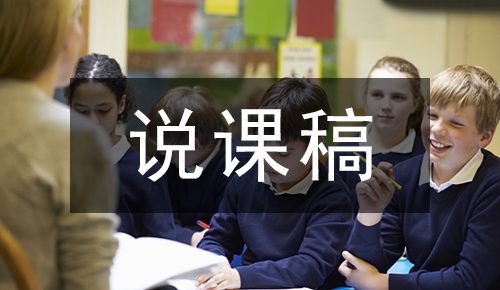
另外通过对我们熟悉经常使用的发明物的历史来开阔眼界,丰富学生的阅历,使学生养成勤于思考,善于总结的好习惯。
2.教学目标
1)知识目标 扩容新单词,提高阅读能力。理解和良好运用被动语态。
2)技能目标 能谈论重要发明的历史及用途,能针对各项发明的用处及特点,发表自己的看法,并说明理由。
3)情感目标 使学生懂得人类的科学发明创造了丰富的物质文明。培养学生的创造发明的能力和愿望
3.教学重点 掌握一般过去时的被动语态
4.教学难点 弄清主动语态与被动语态的差异,通过练习和运用加以巩固
二.学情分析
1.初中生的抽象能力较低,形象思维能力强。但注意力容易分散。本单元通过多媒体课件和教师亲和力的语言,增强兴趣和注意力。
2.初中生的学习心理特点
1)兴趣对英语普遍感兴趣,求知欲盛。
2)记忆对刺激记忆手段多的知识记忆深刻,遵从记忆规律。
3)评价主要通过他人评价初步形成对自己的评价,所以很在乎他人的评价。同时自我意识不断增强。因此在本课教学过程中,注意采用任务型教学为主,通过任务和不同的评价方式,提高学生参与意识。
3.初三上学期学生有较明确的学习动机和态度。本单元通过发明为载体,各种发明和发明家激励学生求知的欲望。
三.教法渗透
1、教学设计思路与教材处理:
《新目标英语》中的具体语言目标是通过各种各样的Tasks来实现的;学生需要运用具体而特定的行动来完成一定的交际任务。整个教学过程中,各种语言结构与语言功能与不同的学习任务有机的结合。任务活动所谋求的效果不是一种机械的语言训练,而是侧重在执行任务中学生自我完成任务的能力和策略的培养;重视形式在完成任务过程中的参与和在交流活动中所获得的经验。因此本节课我将始终引导学生通过完成具体的任务活动来学习语言,让学生为了特定的学习目的去实施特定的语言行动,通过完成特定的交际任务来获得和积累相应的学习经验,让学生在用中学,在学中用。
2、教学原则
l 活动性原则提倡学生主动参与,体验,交流,合作,探究等多种学习。
l 合作性原则以学生为主体,师生合作,生生合作,体现教与学的互动,交往。
l 任务型原则任务驱动—激发动机;任务完成—激励学习积极性;执行任务—培养责任心和合作精神。
l 情感性原则激发学生学习英语的兴趣和始终保持良好的学习情绪。
3、教法运用:
本单元主要采用任务型教学
在本课的任务型语言教学中,我将依据课程的总体目标并结合教学内容,创造性地设计贴近学生生活实际的任务活动,吸引和组织他们积极参与,使学生通过观察、思考、讨论、交流和合作等方式,在一种自然、真实或模拟真实的情境中体会语言、掌握语言的应用。
4.教学手段
1)多媒体辅助:使用自制的课件,使抽象的语言变得直观,为学生运用英语进行交际创设情景,实现师生互动,生生互动和人机互动的多向交流。
2)非测试性评价:传统的评价观念的出发点是学科本位,只重学科,不重学生发展。要体现新课程标准的实施效果,评价体系应该“正确反映外语学习的本质和过程,满足学生发展的需要”。为了达到这一目标,唯有重视形成性评价,充分发挥其积极作用,促进新的评价体系的形成。因此,本课我将各种活动设计成小组活动并开展小组竞赛和填写课堂自我评价表等非测试性评价手段,帮助学生学会自主学习,学会与人合作,培养创新意识以及具备科学的价值观。
四、学法指导
新制定的《英语课程标准》把“培养学生学习英语的兴趣,树立自信心,培养良好学习习惯和形成有效策略,发展自主学习和合作精神”放在了首位。依据课改的精神,我从以下几个方面对学生进行学法指导。
1、学习方法的指导
培养学生观察力,想象力,记忆力以及思维能力。用生动的课件调动学生的感官进行听说读写的训练。
2、学习积极性的调动
我在教学过程中创造一种开放的,和谐的,积极互动的语言氛围,把课堂变成有声有色的舞台,让学生在乐中学。
3、学习能力的培养
通过连贯的听说读写,游戏,竞赛等,培养学生的交际能力,发展他们的思维能力。
4、学习策略的指导
本节课将在课堂活动中把学生分成四人小组的学习小组,让他们围绕着课堂任务分工合作,在活动中相互探讨、相互交流、相互合作,从而获得知识、技能和情感体验,发展他们的能力。创建开放式,探究式的课堂,有意识渗透学习策略的训练。我让学生观察课件画面,回答问题,让学生学会使用认知策略;让学生表演对话,实现交际策略;引导学生交际,主动练习和实践,是调控策略的体现。充分利用多媒体,录音,卡片等是资源策略。
五.教学效果预测;
1.能够掌握被动语态,并运用到一定的语言环境。
2.通过多媒体和任务的完成学生会突破难点,产生一定创造精神。
3.能完成教学目标,调动学生学习热情。
六.课堂教学过程:
Ⅵ.Teaching Procedures
Step Ⅰ Lead-in (2 minutes)
We have inventions everywhere .Inventionsmake us live easily and happily. Without inventions,our lives will be much moredifficult. Today, we will know about a few inventions and talk about thehistory of them.
Showthe pictures of five inventions on the screen: a car,a Tv set, a telephone, acalculator and a computer.
T:Nowlook at these things.What are they?In what order do you think they wereinvented? Number them(1-5) (1=first,5=last)
Volunteersreport the answers.
S1:Ithink the calculator was invented before the computer.
S2:Idon’t think so. I think the calculator was invented after the computer.
Step Ⅱ 1a
This activity reviews vocabulary andintroduces new vocabulary which can be used to talk about inventions.
Read the inventions to the students.
Call the students attention to the five pictures. Tell thestudents that all of these things were invented in the last 150 years. Point toeach picture and let the students tell what it is.
Write the names of the five inventions on theblackboard.
computer, car, calculator, telephone, TV set
Have several different students guess andwrite the dates on the board.
Ask the class to repeat the questions andanswers like this.
T: When was the computer invented? Classrepeat.
Ss: When was the computer invented?
T: Good. Now Tom, what is your guess?
S1: 1965.
T: OK. Tom, repeat after me. The computer wasinvented in 1965.
T: Class, please repeat.
Ss: The computer was invented in 1965.
Repeat the process with several differentinventions.
Tell the children that they will find out thereal dates after they complete the lesson.
After that, ask the students the questionsbelow:
Questions:
1.Which one do you think is the oldest?
2.Which one is the newest?
3.Which one do you think is the oldest or the first invention?
4.Which one is the newest or last invention?
Ask different students to answer thequestions.
Have the students look at the exampleconversation in the box. Ask two students to read this conversation to theclass.
A: I think the telephone was invented beforethe car.
B. Well, I think the telephone was invented after the car.
Read the instructions again to the students.Remind them to remember the inventions from first to last.
Then have the students talk about the fiveinventions in groups of four, using the sample conversation as a model.
Ask several groups to tell the class theiranswers. The rest of the class listen to them and show they have differentanswers by raising their hands.
In the next activity you will find out thereal dates.
Step Ⅲ 1b
This activity gives students practice inunderstanding the target language in spoken conversation.
Get the whole class to read the instructiontogether.
Call the students attention to the five inventions in thepicture. Ask five students to say the names of them.
Then ask them to see the five dates with ablank line in front of each.
Well listen to a girl and a woman talkingabout the five inventions. They will talk about when they were invented. Listencarefully and match the inventions and the dates. Write the correct letter infront of each date as the sample given. Ask them to have a look at the sampleanswer. Tell them the answer in front of 1876 is d. That means that thetelephone, which is letter d, was invented in 1876. Play the recording thefirst time. The students only listen and try to catch the main idea.
Play the recording a second time. Let thestudents match the inventions and the dates. Check the answers by askingseveral to say the answers to the class.
If some of the answers are hard to get forthe children, tell them not to worry and they will make it next.
Then play the recording again. Pause aftereach sentence and let the students repeat. For some difficult sentences, getthe students to repeat several times. Be sure that they make everything clear.
Answers
d 1876 a 1885 e 1927 c 1971 b 1976
Step Ⅳ 1c
This activity provides guided oral practiceusing the target language.
Read the instructions and point to the listof dates in Activity 1b.
You will be talking about the dates thingswere invented with a partner.
Call the students attention to the example in the box. Ask apair of the students to read this conversation to the class.
SA: When was the telephone invented?
SB: Ithink it was invented in 1876.
Write the conversation on the blackboard.Then get the students to practice in pairs, using the information in Activity1b. Tell them to do it like this:
Student A, covers the dates. Students B, asks Student A when the things in the picture above were invented. Thenchange roles and practice again.
Ask several pairs to share theirconversations with the class.
Step Ⅴ Summary
In this class, weve learned to talk aboutthe history of inventions with passive voice. Weve also done some listeningpractice in understanding the target language in spoken conversation. And wevedone much oral practice, using the target language.
Step Ⅵ Homework
1.Write out two conversations in Activity 1a.
2.Write out two conversations in Activity 1 c.
Step Ⅶ Blackboard Design
When was it invented?
Section A
The First Period
1.The names of the five inventions:
computer, car, calculator, telephone, TV set
2.Target language:
A: When was the telephone invented?
B: I think it was invented in 1876.
When was it invented? SectionA(1a—1c) 英文说课稿
Good morning, everyone. It’s my pleasure to interpret my lesson heretoday. The lesson I’m going to talk about is the first period of Book 9 Whenwas it invented? I’ll describe my thoughts on teaching this lesson in thefollowing 4 aspects: analysis of teaching material, ways of teaching andlearning, teaching procedures and blackboard notes.
First of all, I’d like to give some analysis of the material and thestudents. This material is from Book 9 When was it invented? The language goal of this unit is “Talk aboutthe history of the inventions”.
In this period, students will get in touch with the passive voice. It’sthe first time for the students to get in touch with the passive voice. Thisgrammar item is a key point also is a little bit difficult. In this period, Iwill mainly let the students touch with the passive voice. They realizeinitially what the passive voice is constructed and what it expresses. Thatwill be OK. I make "talk about the history of inventions" as thelanguage goal of the class.
OK, that is all about my analysis of material. And then I want to talksomething about the students. In our school, the students dont have much timeto learn some inventions. So I ask them to get ready for this lesson and try tofind information about the four greatest inventions of ancient China and someother famous inventors and their inventions. So they can have a concert of whatthey will learn in this class. I hope the students can hit the following goalsafter this class: they can realize the passive voice initially; they can usethe sentence structures learned to discuss the inventors and their inventions;they can realize the ancient civilization of China, strengthen the proud offeeling.
According to the learning material and the analysis of the students, alsoon the basis of NE C, I set the learning objectives as follows.
By the end of this session, most of the Ss will be able to achieve thefollowing aspects. First of all, most of the Ss will be able to learn and usesome important language points, like calculator, bulb, invent, inventor,invention and so on. Second, Ss will be able to use the following sentencepatterns to talk about inventions: When was the car invented? It was inventedin…Who was the car invented by? It was invented by.... Third, Ss will be ableto write an article about great invention.
These are my teaching and learning objectives. And the focuses lie onhelping Ss improve their ability to find out the information they need afterlistening, and the ability to write an article about a great invention, usingthe passive voice. The difficulty is the using of the passive voice.
Then let me say something about the teaching methods. In order to reach myobjectives, I’ll design some pair works and group works to increase Ss talkingtime on the basis of the student-based teaching method. And I’ll design sometasks to improve Ss’ listening and writing skills mentioned above, on the basisof task-based teaching method. Besides, in order to make the lesson lively andinteresting, I’ll try to use modern equipments.
Ok, so much for the learning strategies. Next comes to my most importantpart, the learning procedures. My Ss will learn the lesson in 7 steps.
Step one is warming-up. First, I’ll greet the Ss with daily conversations.And then I’ll show them some pictures of the ceremony (2008 Olympic Games ) onthe screen to talk about the Chinese history and the four great inventions.
Then I’ll show the pictures of the four great inventions, and askstudents: Who invented …? And then present the new sentence patterns: -Who wasthe paper making invented by ? -It was invented by Cai Lun. -When was itinvented ?- It was invented in Donghan Dynasty After that, ask students to ask and answer inpairs, using the above sentence patterns.
Then I’ll say that we have known some ancient inventions, ask Ss “ Do youknow any modern inventions?” Ask Ss to tell as many as they can, such as car,telephone, light bulb, computer and so on. And then ask Ss: “When were theyinvented? And who were they invented by?” So we will come to step 3. Ss mayfind out the answer after listening.
After the third step, I’ll show more inventions on Bb, and ask Ss todiscuss them in groups of four. Then give a report. Ss should use the followingsentence patterns while they are talking.
- When was the laser invented?- It was invented in
- Who was it invented by?- It was invented by
InventionsWhen was it invented?Who was it invented by?
Laser1960Tony
airplane1903Light
E-mail 1971Tomlinson
telegraph1895Marconi
air-conditioner 1902Wailers
auto- dub machine1967Belon
ball pen1938Parishes
After the discussion part, we’ll go to step5-writing. Because after thelistening and discussion, it’s time for Ss to write something about aninvention. But first I’ll give Ss some oral examples about it. And examples cangive these students who are not good at English some help. And this oralpractice can make them easy to write the article. After the oral practice,we’ll come to write the article about a great invention. Before Ss write it,first I’ll help them how to begin the article. This can improve Ss’ learningstrategy. Before Ss write it by themselves, I’ll give them my examples, whichcan help those Ss whose English are not good to write. Next, the Ss will writethe article, and after they finish it, I’ll show them 2 articles from them toshare with them..
After the writing, it’s time to summarize what they have learned, andafter that, do some exercises, that will help to consolidate what they havelearned.
Exercises:
1.将下列主动句改成被动句:
1) Many people speak English.
2) We should look after our books well.
3) They make wood into desks.
4) They invited Tom to see a film.
2. They were invented ___ Julie Thompson.
A. as B. for C. by D. to
3. This watch _____ China
A. was made in B. was made by
4. — ____ was the car invented?— In1983.
A. When B. Why C How D. Who
5. Basketball ____ by people allover the world.
A. is enjoyed B. is like C. love D. enjoyed
Finally, I’ll tell Ss the homework and say goodbye to them.
That’s all about my teaching procedures. Next I’ll say something about theBb design. As we know Bb note is the miniature of the whole lesson. It candisplay the procedures of the lesson and the language points learned in thislesson. It’s good for Ss to get the clear idea of the whole lesson. And teachercan use it to review.
That’s all about my lesson talk. Thanks for listening it. Bye!
板书:
When was it invented? Period 1
When was … invented?invent
It was invented in …inventor
Who was … invented by? invention
It was invented by…calculator
Bulb
When was it invented? SectionA 英文 说课稿
A. Teaching material analysis:
1. My topic today is 1a-2c of section A in Go for it Unit 9. The languagegoal of this unit is “Talk about the history of the inventions”. The key wordsare:
scoop, adjustable, heel, battery, operate, slipper, bulb, invent, be usedfor.
2. The key expressions listed as follows :
When was the car invented?It wasinvented in
Who was the car invented by? It wasinvented by...
What is it /are they used for? It is/They are used for...
3. The difficult point is the new language function of passive voice.
B. Teaching anticipation
It’s the first time for the students to get in touch with the passivevoice. This grammar item is a key point also is a little bit difficult. In thisperiod, I will mainly let the students touch with the passive voice. Theyrealize initially what the passive voice is constructed and what it expresses.That will be OK. I make "talk about the history of inventions" as thelanguage goal of the class. In our school, the students dont have much time tolearn some inventions. So I ask them to get ready for this lesson and try tofind information about the four greatest inventions of ancient China and someother famous inventors and their inventions. So they can have a concert of whatthey will learn in this class. I hope the students can hit the following goalsafter this class:
1. They can realize the passive voice initially.
2. They can use the sentence structures learned to discuss the inventorsand their inventions.
3. They can realize the ancient civilization of China, strengthen theproud of feeling.
C. My thought for the design of this class
In this class, I will lead the students to have a tour to an Africanoriginal tribe and recommend some inventions in our daily life to improve theiroriginality situation, thus develop the topic. The activities involve three keysentence structures of this lesson:
When was it invented?
Who was it invented by?
What is it used for?
My post task is a letter from a student to Africans. It introduces theancient four greatest inventions of China. But there are many mistakes aboutthe passive voice. I get the students to correct them. Through the practice, the students canconsolidate what they learned today. What’s more, it can make the studentsrealize the glorious and ancient civilization of China.
D. Teaching procedures:
Step 1. Warming up
I present the language targets on the first page of ppt. It can makestudents realize what they are going to learn before class. So they will have abetter effect to learn it well.
Step 2. Lead-in
1. T: Today we are going to Africa. Well visit an ancient tribe. (Presentthe African original tribe picture)
T: They live in the house like this. (A dark house) What do they need?
S: Bulb.
Present the bulb that student said. Explain that this is an invention
T: It’s a kind of invention.
2. Present Edison’s picture,
T: Who is this man? (Edison)
S: He was an inventor.( Present the vocabulary inventor)
T: He invented many inventions.
Please say something about Edisonand the bulb.
S: Edison invented the bulb.
(The student can describe with the active voice which learned before)
Then change the positions, and then let the student say the relationagain.
(Design aim: I want to make the students find out what the passive voiceis. It will develop the ability of independent study)
3. Repeat the same steps with some other inventions (car and telephone).
Step 3. Activity1
T: The Africans want to know when the inventions were invented.
1. Order the inventions (1a)
Get the students to guess in whatorder the inventions were invented and number them from 1-5. They can discusswith their partners:
S1: I think the telephone wasinvented before the car.
S2: Well, I think the car wasinvented after the telephone.
2. Listen to the tape and find the time of the inventions. ( 1b )
Then check the answer and knowwhose order is right.
3. Pairwork (1c )
Make conversations using the timetable in 2a.
(Goal: do 1a-1c. withdraw the knowledge dot and practice.)
Step 4. Activity2 Have a try
T: Let’s learn some other inventions.
- When was the laser invented?- It was invented in
- Who was it invented by?- It was invented by
InventionsWhen was it invented?Who was it invented by?
Laser1960 Tonys
airplane1903 Light
E-mail1971 Tomlinson
telegraph1895 Marconi
air-condition1902 Wailers
auto-dub machine1967 Belon
ball pen1938 Parishes
(Goal: practice the key sentence structures with some other inventions andopen the students mind at the same time)
Step 5. Activity3 What are they used for?
T: The Africans know when the inventions were invented. And they want toknow what they are used for.
Show a conversation between Bell and an African
African: What’s the telephone used for?
Bell:It’s used for talking with people.
1. What are they used for? (Present a sheet of inventions)
1) Discuss in groups of four.
2) Get the students to guess. Theycan have their own ideas.
2. Guessing game
Divide the whole class into two groups and have a competition. The groupgives out more correct answers in three minutes will be the winners. One oftheir members will read for them with the information in the cards. The wordsin the cards are like this: Bell, telephone, 1876, talking with people
Students can rob the answer while reading the information.
The teacher needs to get ready for the cards before class.
(Goal: play a guessing game like Lucky 52 which students are interestedin. Its used for consolidating the key sentences and passive voice.)
Step 6. Activity4 Reading
T: The Africans are very glad to know so much about the inventions. Sothey’d like to read some other articles about other modern inventions.
Give the listening material and the forms to the students before class
1. Read the conversation and fill inthe chart
InventionsWho was it / they invented by? What is it/are they used for?
Shoes with adjustable heelsscooping really cold ice cream JulieThompson
2.Check the answer
3.Read after the tape together and read the new words
(Goal: 2a/2b is listening material. I design it as a task reading. We havelearned the sentence structures in the step above. )
Step 7. Activity5Small inventors
T: Show time! Show your inventions to the Africans! (Prepared)
1. Survey
Four students as a group, one student works as a reporter to interview theother three students and fill in the chart.
InventionsWho was it invented by?When was it invented?What is it use for?
2. Report Make a report about theirnew inventions
… Was invented by … it was invented in.... It is used for
(Goal: practice the key sentence structures surrounding the language goal.Develop the student’s have fantastic ideas and consciousness of the inventioninnovation)
Step 8.Activity6 the four greatestinventions of ancient China
1. Show the four inventions, the inventors, the invented time, the usageto get the students to match them.
2. Show a letter from a student to an African, there are many mistakes,get the students to correct them.
3. Write the correct letter if time is permitted.
(Goal: make the student consolidate passive voice. students can realizethe ancient civilization of Chinese, self-confident and proud of feelings.)
Step 9. Summary
1. The passive voice
被动语态的构成: 助动词(be)+动词过去分词 (done)
am/is( are) + done 一般现在时
was (were) + done 一般过去时
2. Expressions
When was the car invented? It was invented in 1876.
Who was the car invented by?It was invented by Ford.
What are they used for?They are used for driving.
Step10 .Homework
• Copy the new words three timesand remember them
• Finish Homework A Page 1
• Write the corrected letter to theAfrican.
• Preview : new words andexpressions
When was it invented? Section A(1a—1c) 说课稿
各位评委老师:
大家好!我说课的内容是新目标英语九年级上册第九单元“When was it invented?’’的第1课时,即Section A(1a—1c)。下面我将从以下几个方面进行说课。
一.教材分析
这个单元围绕“发明”这个话题,让学生通过了解不同东西的发明历史和用途来学习语法项目——被动语态。再通过听、说、读、写训练熟练掌握语言知识和技能,最后让学生分析自己身边的发明的优缺点,从而进一步认识世界并改造世界。同时,教材内容从基本语言知识到语言综合知识的运用,层层递进,引导学生进行有目的学习语言。
二.教学目标
1.知识语言目标:能够让学生掌握重点词汇:invent,calculator,computer,car等。
让学生掌握一般现在时和一般过去时的被动语态以及其陈述句和疑问句。
2. 能力目标: 学会谈论发明的历史,认识些被发明的事物;能用被动语态进行对话。
3. 情感与价值:树立科学观念,培养积极探索,勇于创新的精神。
三.教法策略
以任务型教学策略为主,利用多媒体向学生展示发明物图片、听力训练法(处理听力材料)、并辅助个人、小组对话和图片等兴趣策略教学。如在新授单词时,通过一些图片,幻灯片等进行分析教学,以致于从视角引起他们注意从而记住单词。采取任务型教学策略的目的是主要是让学生多练多用,在做中学、学中乐、乐中掌握知识。
四.学习策略
通过角色表演,掌握如何利用被动语态谈论发明,在完成任务的活动中主动的学习语言,养成继续学习英语和学好英语的良好习惯。强调学生不仅要在课上积极发言、多练,并鼓励他们课后成立英语学习兴趣小组、英语角等,且鼓励学生积极参加。
五.重点、难点分析
重点词汇在对话和图片中解决。如:invent, calculator,computer,car等。
难点:听力训练;用被动语态谈论发明的历史和发明的用途来进行口语训练。
六.教学准备:黑板、图片、录音机、投影仪、一些发明实物。如:玩具汽车、电话机等。
七.教学过程
1、课前任务设置,在每一节课,我让学生提前预习。课前3分钟我让学生学唱“big ”big world ”的歌曲,目的是激发他们学习热情,另一方面铃声响的时候,首先检查学生对第八单元单词的记忆情况。然后让学生看着屏幕,用“When was carinvented?”等句子问,用It was invented in1885回答,之后通过图片展示推出其他的发明和新授的单元内容。在此期间,让学生感知“When was it invented? It was invented in…”的重点句型结构,把单词教学融入句型,培养学生在情境中理解记忆单词的能力。
2、为了更好的提高学生的理解能力,让学生有目的地完成Activity1a.请学生注意五幅图片,告诉学生这些发明是在过去150年发明的。通过投影仪展示图片,同时让学生说出发明的名称。老师在黑板上写下:computer,car,calculator,telephone,然后说出问题:When was thecomputer invented?再回答: The computer was invented in 1976.学生重复When was thecomputer invented? The computer was invented in 1976.接下来请学生看方框中的对话并复述。然后要求学生就五个发明物或自己的小发明进行小组对话。从而提高学生口语能力,帮助学生掌握被动语态。
3.完成1a部分后,为了更好的巩固学生对发明的理解程度,让他们通过1b进行听力训练,培养学生在用中学、学中用的能力。首先请一个学生说出1b 中五个发明名字,然后播放录音,同时让学生把发明物和发明的日期配对,最后检查答案。
4.为了更好的运用被动语态,请学生练习1c,然后请两个同学把对话说给同学们听.When was the telephone invented? I think it was invented in 1876.接着让学生用1a里的发明物或自己的小发明进行分组练习,最后请几组把他们的对话和全班同学一起来分享。
5、总结本节课所学的知识,梳理知识结构。
6、布置作业
总之,这堂课通过听、说、读、写训练,让学生熟练掌握用被动语态来谈论发明的历史和用途,利用二人小组活动,学生讨论各自对发明创造的想法以及他们自己的小发明,开阔学生的思路,让学生展开丰富的想象翅膀,培养学生的创新精神。
When was it invented? Section B(1a—2c)英文说课稿
1.Analysis of teaching material
2.Analysis of teaching methods
3.Teaching procedures
4.Teaching reflection
Part1 Analysis of the teachingmaterial
1. Status and function: This is thefirst part of Section B, it links thepreceding with the following in Unit 9. Not only does it help the studentsreview the food words and the Passive Voice they have learnt before, but alsoit helps them learn to describe different tastes and talk about the history ofthe invention. Such a topic is related to daily life, so it is helpful toinspire the studentslearning motivation and interest.
2. Teaching aims and demands
Knowledge aims:
☆ The target words: crispy, salty, sour, chef, sprinkle, by mistake.
☆ The target language: Did you know potato chips were invented by mistake?
Wow, I didn’t know that. Who invented them? ...etc.
Ability aims:
☆Be able to describe different tastes using the target words.
☆Train the studentslistening, speaking, reading and writingskills with the target language.
Moral aims:
Cultivate the studentsability of observation, imagination andtheir spirit of innovation.
3. Teaching emphasis and difficulties:
Important points
The target words and language.
(According to the English syllabus and the language structures in thislesson.)
Difficult points:
The listening practice and correctly express the history of the invention.
(According to the teaching prediction and the students cognitive level)
Part 2 Analysis of teaching methods
1. Teaching methods:
“Task-based teaching method “with the help of useful situations to classifythe tasks and give different students different evaluations.
(To make language learning successful through a step-by-step progressionthat builds confidence and leads to open-ended activities.)
2.Teaching aids:
Multimedia computer, Tape recorder, PowerPoint.
(According to the studentspsychological characteristics. They enjoymusic, pictures and cartoons.)
Part 3 Teaching procedures
Step 1 Brainstorming
Play guessing games: what inventions are they?
One student comes to the front to guess, the others describe an inventionshown on the screen using the passive sentences: It’s used for… It was inventedby…It was invented in…etc.
Take turns to show ‘light bulb, alarm clock, microwave oven’with someother helpful pictures that center about them nearby on the screen.
(Purpose of designing: To guide the students to review what they learnedlast lesson)
Step 2 Leading-in
T: The microwave oven reminds me of some delicious food. I will play acartoon called “music food” My favorite food is in it. Try to guess what it is.
Every time when they give a guess, I will express my like and dislike by usingsome adjectives like sweet, crispy, salty, sour . Make sure they know themeanings of them. For example:
S:Chocolate
T: It’s very crispy, but it’s too sweet. I don’t like it Can you guess themeaning of ‘crispy’? It describes food that is hard .dry and easily broken.
S :Milk.
T:I prefer sour milk to milk. Do you know ‘sour’? Oranges sometimes tastesour.
S: Fish.
T: yes! Fish is my favorite, and I especially like salty fish that issprinkled with a lot of salt.
During this course, write down the new words on the blackboard..Finallyplay a leading role to read them.
(Purpose :To arouse the students interest ,createuseful situations for them to learn the new words. Prepare for the next step. )
Step 3 Practice
Task One writing
1a.Show four food pictures on the screen and get the students to describehow the food tastes and write them down.
1b.Ask them to list the words of the food that has different tastesaccording to the headings on the screen as many as possible .
sweet crispy salty sour
The teacher moves around the classroom to provide help for the studentswho have trouble in spelling some hard words and choose three students whowrite different words from one another.
(Purpose: To practice using the target words and review the food wordsthey have learnt before.)
Task Two Speaking and acting
Get the three students to the front, divide the class into four groups:
Sweet Group , Crispy Group, Salty Group , Sour Group
Game begins: The three students read their words loudly in class one byone without repetition, the group members should stand up as soon as they heara word that belongs to them. Call out the students who stood up by mistake andhave them guess the meaning of ‘by mistake’.
(Purpose: This is employed to show the words they wrote and link thetarget words with the food words, and get the whole class moving.)
您可能喜欢的文档
查看更多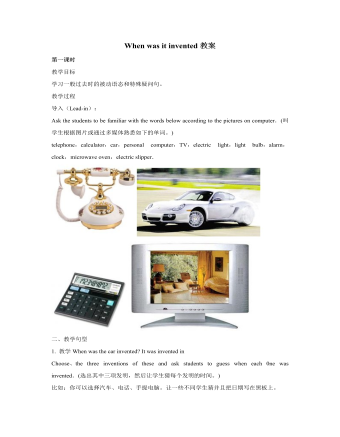
人教版新目标初中英语九年级下册When was it invented教案
- 页数:12页
- |大小:586.50KB
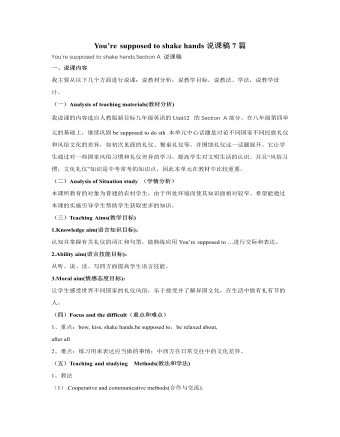
人教版新目标初中英语九年级下册You’re supposed to shake hands说课稿7篇
- 页数:20页
- |大小:107.00KB
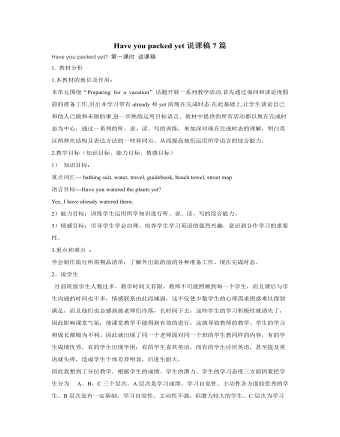
人教版新目标初中英语九年级下册Have you packed yet说课稿7篇
- 页数:41页
- |大小:192.00KB
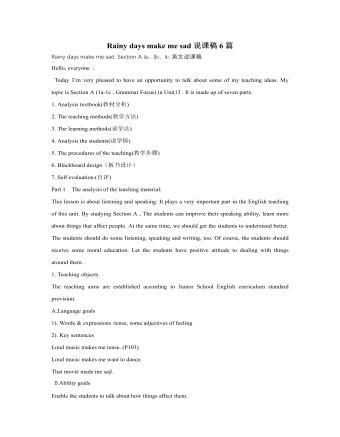
人教版新目标初中英语九年级下册Rainy days make me sad说课稿6篇
- 页数:21页
- |大小:113.00KB
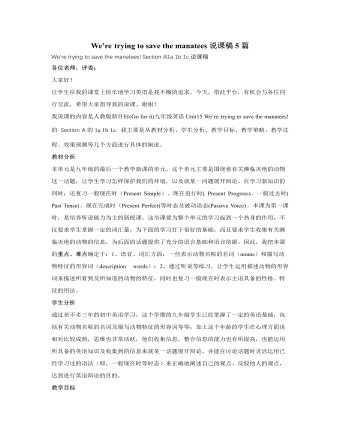
人教版新目标初中英语九年级下册We’re trying to save the manatees说课稿5篇
- 页数:29页
- |大小:154.50KB
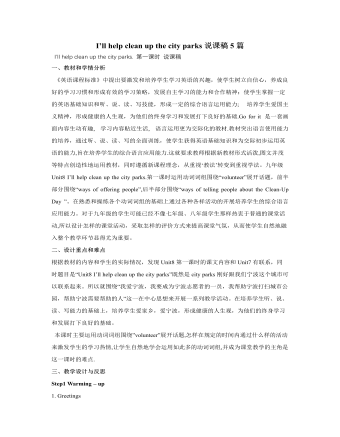
人教版新目标初中英语九年级下册I’ll help clean up the city parks说课稿5篇
- 页数:17页
- |大小:95.50KB
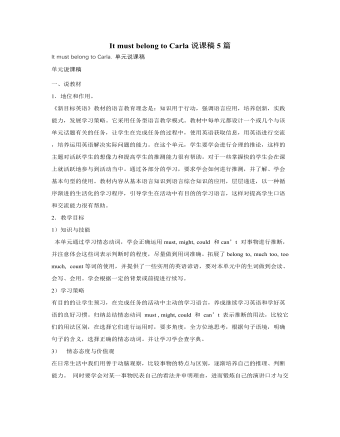
人教版新目标初中英语九年级上册It must belong to Carla说课稿5篇
- 页数:22页
- |大小:93.50KB
热门说课稿
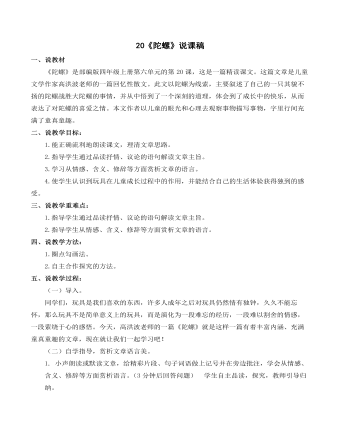
《陀螺》说课稿
- 页数:4页
- |大小:39.00KB
- 说课稿
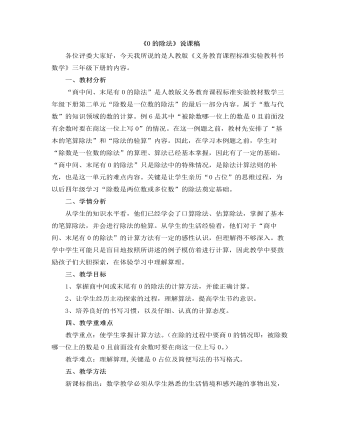
小学数学人教版三年级下册《0的除法》说课稿
- 页数:6页
- |大小:34.92KB
- 说课稿
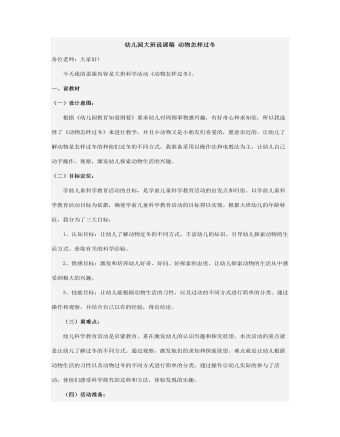
幼儿园大班说课稿 动物怎样过冬
- 页数:3页
- |大小:36.00KB
- 说课稿
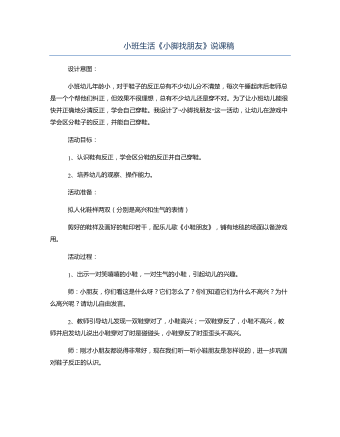
小班生活《小脚找朋友》说课稿
- 页数:2页
- |大小:33.31KB
- 说课稿
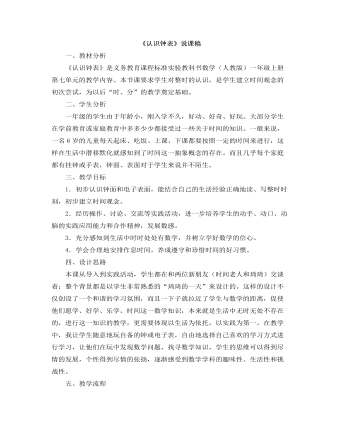
小学数学人教版一年级上册《认识钟表》说课稿
- 页数:4页
- |大小:24.27KB
- 说课稿
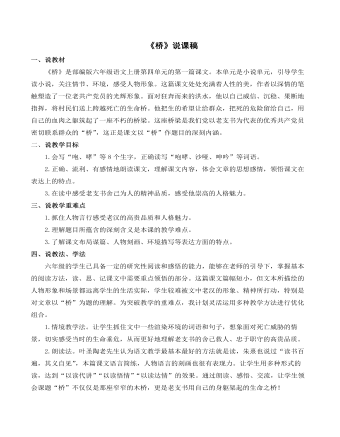
《桥》说课稿
- 页数:5页
- |大小:42.50KB
- 说课稿
今日更新

精选高中生期末评语
- 页数:42页
- |大小:7M

××县招商局2024年上半年工作总结
- 页数:12页
- |大小:142.54KB

“四零”承诺服务创建工作总结
- 页数:5页
- |大小:39.83KB
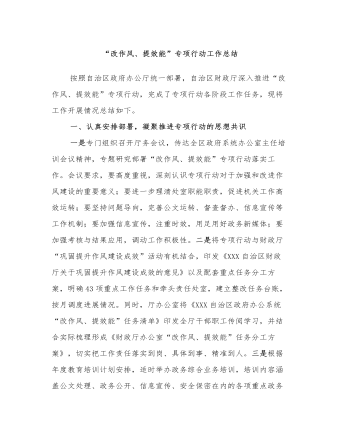
“改作风、提效能”专项行动工作总结
- 页数:6页
- |大小:139.05KB
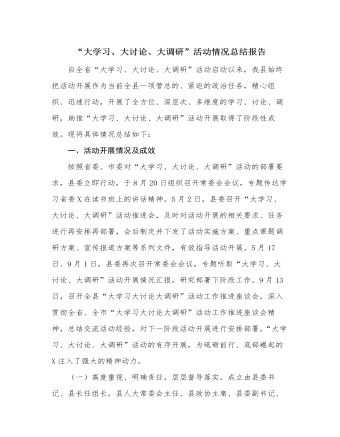
“大学习、大讨论、大调研”活动情况总结报告
- 页数:7页
- |大小:26.12KB
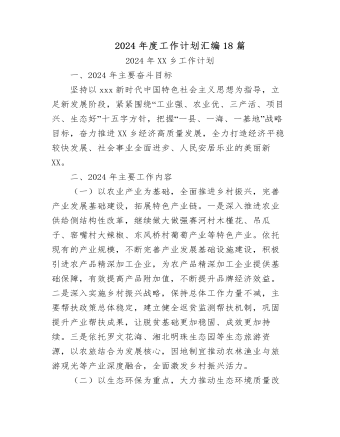
2024年度工作计划汇编(18篇)
- 页数:72页
- |大小:196.93KB





